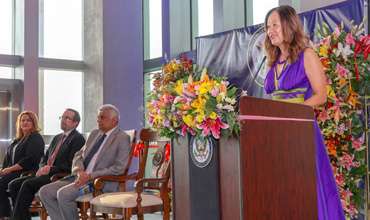Shall we abandon the Christmas Tree?
Professor Theodore Fernando, The Open University of Sri Lanka.
Christmas Tree has become the one of the most popular topic in the public sphere, during this Christmas season, due to the publicity given to it by certain interest groups/individuals having their own agenda. Purpose of this article however, is to do a semiotic analysis of the Christmas tree, from an academic perspective since symbols and rituals play a very important role in our lives.
 What is semiotics. To put it in everyman’s language, semiotics is the science of symbols.
What is semiotics. To put it in everyman’s language, semiotics is the science of symbols.
According to Ferdinand de Saussure (“so-SIR”) (1857-1913), the founder of semiotics,
“It is possible to conceive of a science which studies the role of signs which can be applied to many different fields, including media studies, theatre and music and art. It is a part of social life. It would form part of social psychology, and hence of general psychology. We shall call it semiology (from the Greek semeîon, 'sign'). It would investigate the nature of signs and the laws governing them.”
Although the earliest origins of semiotics can be traced back to Aristotle and Augustine, it didn’t begin to be fully developed until the late nineteenth and early twentieth centuries. Semiotics is primarily concerned with the analysis of signs and symbols and their meaning. Signs and symbols can be studied, not only in language (both written and spoken forms), but also in rituals, culture, images and art – in fact, anything that can be ‘read’ as text.Semiotic researchers do not study signs in isolation, rather they study the conventions governing the use of signs and sign systems .
A sign is an entity which signifies another entity.
We make meanings through our creation and interpretation of signs. Charles Sanders Peirce (“purse”) (1839 –1914)
‘Semiotics is concerned with everything that can be taken as a sign’ (Eco, 1976: 7)
Words, images, actions and objects can all be studied as signs, as long as they have been recorded in some way and can be studied (e.g. in writing or on video)
Nöth (1990) refers to semiotics as the ‘science of meaning’
Basically, semiotics is the study of signs and their meanings! Signs include words, gestures, images, sounds, and objects. According to Ferdinand de Saussure, a founder of modern semiotics, sign consists of two parts: the signifier (the form which the sign takes) and the signified (the concept represents).
For example a picture of a school bulidng connots education, the childern who study in that building, incliding teachers, parents, and many other activities connected with educaiton. A Symbol of a Cross can connote a place of worship, A hospital, or according to celtic spirituality, the four points of a cross represent self, nature, wisdom, and higher power or being. Crosses suggest transition, balance, faith, unity, temperance, hope, and life. They represent relationships and a need for connection to something. Therefore when analysing symbols and words one has to look at the direct meaning which is denotative as well as other meanings associated with the words namly connotiatives. A red rose may symbolyse love, devotion, sacrifice. With this background, in order to appreciate the symbol of Chrstmas tree, it is appropritae first we look at the history of Chrstmass tree.
The evergreen fir tree has traditionally been used to celebrate winter festivals (pagan and Christian) for thousands of years. Pagans used branches of it to decorate their homes during the winter solstice, as it made them think of the spring to come. The Romans used Fir Trees to decorate their temples at the festival of Saturnalia. Christians use it as a sign of everlasting life with God.
The evergreen tree was an ancient symbol of life in the midst of winter. Romans decorated their houses with evergreen branches during the New Year, and ancient inhabitants of northern Europe cut evergreen trees and planted them in boxes inside their houses in wintertime. Many early Christians were hostile to such practices. The second-century theologian Tertullian condemned those Christians who celebrated the winter festivals, or decorated their houses with laurel boughs in honor of the emperor:
"Let them over whom the fires of hell are imminent, affix to their posts, laurels doomed presently to burn: to them the testimonies of darkness and the omens of their penalties are suitable. You are a light of the world, and a tree ever green. If you have renounced temples, make not your own gate a temple."
But by the early Middle Ages, the legend had grown that when Christ was born in the dead of winter, every tree throughout the world miraculously shook off its ice and snow and produced new shoots of green. At the same time, Christian missionaries preaching to Germanic and Slavic peoples were taking a more lenient approach to cultural practices—such as evergreen trees. These missionaries believed that the Incarnation proclaimed Christ's lordship over those natural symbols that had previously been used for the worship of pagan gods. Not only individual human beings, but cultures, symbols, and traditions could be converted.
Of course, this did not mean that the worship of pagan gods themselves was
often hung with round pastry wafers symbolizing the Eucharist, which developed into the cookie ornaments decorating German Christmas trees today.
The custom gained popularity throughout the 17th and 18th centuries, against the protests of some clergy. Lutheran minister Johann von Dannhauer, for instance, complained (like Tertullian) that the symbol distracted people from the true evergreen tree, Jesus Christ. But this did not stop many churches from setting up Christmas trees inside the sanctuary. Alongside the tree often stood wooden "pyramids"—stacks of shelves bearing candles, sometimes one for each family member. Eventually these pyramids of candles were placed on the tree, the ancestors of our modern Christmas tree lights and ornaments.
Nicholas and Wenceslas
It also took a long time for trees to become associated with presents. Though legend connects the idea of Christmas gifts with the gifts the Magi brought Jesus, the real story is more complicated. Like trees, gifts were first a Roman practice—traded during the winter solstice. As Epiphany, and later Christmas, replaced the winter solstice as a time of celebration for Christians, the gift-giving tradition continued for a while. By late antiquity it had died out, although gifts were still exchanged at New Year's.
Gifts were also associated with St. Nicholas, bishop of Myra (in modern-day Turkey), who became famous for giving gifts to poor children. His feast day (December 6) thus became another occasion for gift exchanges. During the early Middle Ages, Christmas gifts most often took the form of tributes paid to monarchs—although a few rulers used the holiday season as an opportunity to give to the poor or to the church instead (most notably Duke Wenceslas of Bohemia, whose story inspired the popular carol, and William the Conqueror, who chose Christmas 1067 to make a large donation to the pope).
Like trees, gifts came "inside" the family around the time of Luther, as the custom of giving gifts to friends and family members developed in Germany, the Netherlands, and Scandinavia. Often these were given anonymously, or hidden. One Danish custom was to rewrap a gift many times with different names on each wrapper, so that the intended recipient was only discovered when all the layers were opened
Nobody is really sure when Fir trees were first used as Christmas trees. It probably began about 1000 years ago in Northern Europe. Many early Christmas Trees seem to have been hung upside down from the ceiling using chains (hung from chandeliers/lighting hooks).
Other early Christmas Trees, across many parts of northern Europe, were cherry or hawthorn plants (or a branch of the plant) that were put into pots and brought inside so they would hopefully flower at Christmas time. If you couldn't afford a real plant, people made pyramids of woods and they were decorated to look like a tree with paper, apples and candles. Sometimes they were carried around from house to house, rather than being displayed in a home.
It's possible that the wooden pyramid trees were meant to be like Paradise Trees. These were used in medieval German Mystery or Miracle Plays that were acted out in front of Churches on Christmas Eve. In early church calendars of saints, 24th December was Adam and Eve's day. The Paradise Tree represented the Garden of Eden. It was often paraded around the town before the play started, as a way of advertising the play. The plays told Bible stories to people who could not read.
The first documented use of a tree at Christmas and New Year celebrations is argued between the cities of Tallinn in Estonia and Riga in Latvia Both claim that they had the first trees; Tallinn in 1441 and Riga in 1510. Both trees were put up by the 'Brotherhood of Blackheads' which was an association of local unmarried merchants, ship owners, and foreigners in Livonia (what is now Estonia and Latvia).
Little is known about either tree apart from that they were put in the town square, were dance around by the Brotherhood of Blackheads and were then set on fire. This is like the custom of the Yule Log. The word used for the 'tree' could also mean a mast or pole, tree might have been like a 'Paradise Tree' or a tree-shaped wooden candelabra rather than a 'real' tree.
In the town square of Riga, the capital of Latvia, there is a plaque which is engraved with "The First New Year's Tree in Riga in 1510", in eight languages.
In 1584, the historian Balthasar Russow wrote about a tradition, in Riga, of a decorated fir tree in the market square where the young men “went with a flock of maidens and women, first sang and danced there and then set the tree aflame”. There's a record of a small tree in Breman, Germany from 1570. It is described as a tree decorated with "apples, nuts, dates, pretzels and paper flowers". It was displayed in a 'guild-house' (the meeting place for a society of business men in the city). In modern terms it was the public sphere, a place where people flocked to discuss important events in their village.
The first person to bring a Christmas Tree into a house, in the way we know it today, may have been the 16th century German preacher Martin Luther. A story is told that, one night before Christmas, he was walking through the forest and looked up to see the stars shining through the tree branches. It was so beautiful, that he went home and told his children that it reminded him of Jesus, who left the stars of heaven to come to earth at Christmas. Some people say this is the same tree as the 'Riga' tree, but it isn't! The Riga tree originally took place a few decades earlier.
The custom of having Christmas trees could well have travelled along the Baltic sea, from Latvia to Germany. In the 1400s and 1500s, the countries which are now Germany and Latvia were them part of two larger empires which were neighbors.
Another story says that St. Boniface of Crediton (a village in Devon, UK) , (one of the catholic saints) left England and traveled to Germany to preach to the pagan German tribes and convert them to Christianity. He is said to have come across a group of pagans about to sacrifice a young boy while worshipping an oak tree. In anger, and to stop the sacrifice, St. Boniface is said to have cut down the oak tree and, to his amazement, a young fir tree sprang up from the roots of the oak tree. St. Boniface took this as a sign of the Christian faith and his followers decorated the tree with candles so that St. Boniface could preach to the pagans at night.
There is another legend, from Germany, about how the Christmas Tree came into being, it goes:
Once on a cold Christmas Eve night, a forester and his family were in their cottage gathered round the fire to keep warm. Suddenly there was a knock on the door. When the forester opened the door, he found a poor little boy standing on the door step, lost and alone. The forester welcomed him into his house and the family fed and washed him and put him to bed in the youngest sons own bed (he had to share with his brother that night!). The next morning, Christmas Morning, the family were woken up by a choir of angels, and the poor little boy had turned into Jesus, the Christ Child. The Christ Child went into the front garden of the cottage and broke a branch off a Fir tree and gave it to the family as a present to say thank you for looking after him. So ever since them, people have remembered that night by bringing a Christmas Tree into their homes!
In Germany, the first Christmas Trees were decorated with edible things, such as gingerbread and gold covered apples. Then glass makers made special small ornaments similar to some of the decorations used today. In 1605 an unknown German wrote: "At Christmas they set up fir trees in the parlours of Strasbourg and hang thereon roses cut out of many-colored paper, apples, wafers, gold foil, sweets, etc."
At first, a figure of the Baby Jesus was put on the top of the tree. Over time it changed to an angel/fairy that told the shepherds about Jesus, or a star like the Wise Men saw.
The first Christmas Trees came to Britain sometime in the 1830s. They became very popular in 1841, when Prince Albert (Queen Victoria's German husband) had a Christmas Tree set up in Windsor Castle. In 1848, drawing of "The Queen's Christmas tree at Windsor Castle" was published in the Illustrated London News. The drawing was republished in Godey's Lady's Book, Philadelphia in December 1850 (but they removed the Queen's crown and Prince Albert's moustache to make it look 'American'!). The publication of the drawing helped Christmas Trees become popular in the UK and USA.
In Victorian times, the tree would have been decorated with candles to represent stars. In many parts of Europe, candles are still used to decorate Christmas trees.
Tinsel and The Legend of the Christmas Spider
Tinsel was also created in Germany, were it was originally made from thin strips of beaten silver. But when plastic/man made tinsel was invented, it became very popular as it was much cheaper than real silver and also lighter to go on the tree!
There are also folk stories about how tinsel was created - by The Christmas Spider!
These tales seem to have started in Eastern Germany or Ukraine but are also told in parts of Finland and Scandinavia
All the versions of the story involve a poor family who can't afford to decorate a Tree for Christmas (in some versions the tree grew from a pine cone in their house, in others the family have bought a tree into the house). When the children go to sleep on Christmas Eve a spider covers the tree in cobwebs. Then on Christmas morning the cobwebs are magically turned into silver and gold strands which decorate the tree!
Some versions of the story say that it's the light of the sun which changed the cobwebs into silver and gold but other versions say it's St Nicholas / Santa Claus / Father Christmas / das Christkind which made the magic happen.
In parts of Germany, Poland, and Ukraine it's meant to be good luck to find a spider or a spider's web on your Christmas Tree. Spider's web Christmas Tree decorations are also popular in Ukraine. They're called 'pavuchky' (which means 'little spider') and the decorations are normally made of paper and silver wire. You might even put an artificial spider's web on your tree!
Christmas Tree Lights
Because of the danger of fire, in 1895 Ralph Morris, an American telephonist, invented the first electric Christmas lights, similar to the ones we use today.
In 1885 a hospital in Chicago burned down because of candles on a Christmas Tree! And in 1908 insurance companies in the USA tried to get a law made that would ban candles from being used on Christmas Trees because of the many fires they had caused! So we have to say a big thank you to Ralph Morris for making Christmas safer!
The most lights lit at the same time on a Christmas tree is 194,672 and was done by Kiwanis Malmedy / Haute Fagnes Belgium in Malmedy, Belgium, on 10 December 2010!
Many towns and villages have their own Christmas Trees. One of the most famous is the tree in Trafalgar Square in London, England, which is given to the UK by Norway every year as a 'thank you' present for the help the UK gave Norway in World War II. The White House in the USA has had a big tree on the front lawn since the 1920s.
The record for the most Christmas trees chopped down in two minutes is 27 and belongs to Erin Lavoie from the USA. She set the record on 19th December 2008 on the set of Guinness World Records: Die GroBten Weltrekorde in Germany.
Artificial Christmas Trees really started becoming popular in the early 20th century. In the Edwardian period Christmas Trees made from colored ostrich feathers were popular at 'fashionable' parties. Around 1900 there was even a short fashion for white trees - so if you thought colored trees are a new invention they're not! Over the years artificial tress have been made from feathers, papier mâché, metal, glass, and many different types of plastic .
The tallest artificial Christmas tree was 52m (170.6ft) high and was covered in green PVC leaves!. It was called the 'Peace Tree' and was designed by Grupo Sonae Distribuição Brasil and was displayed in Moinhos de Vento Park, Porto Alegre, Brazil from 1st December 2001 until 6th January 2002.
In many countries, different trees are used as Christmas trees. In New Zealand a tree called the 'Pohutakawa' that has red flowers is sometimes used and in India Banana or Mango trees are sometimes decorated.
With above background, it is interesting to note that . during his Angelus audience on Sunday, Pope John Paul II had discussed the symbolism of the Christmas season, focusing on the Christmas tree as "an ancient custom that exalts the value of life".
Catholic World News reports that the Holy Father said that the life symbolism is derived from the fact that the evergreen tree remains unchanged through the harshness of winter. When gifts are arranged under the tree, he said, it because a symbol of "the tree of life, a figure of Christ, God's greatest gift to all men."
However, it is also, said that , Pope made a point of saying that the gifts exchanged at Christmas should not be purely material and commercial. The "tree of life," he said, points the way toward an exchange of spiritual goods: of brotherhood and love.
According to the Pope ,before making his remarks on the Christmas tree, that the most important symbol of the season is the Christmas crib, about which he spoke one of his Sunday public audience.
To summarize , the Christmas Tree represents or symbolizes the Tree of Paradise from which we stem and towards which we tend. Let us consider A Christmas Tree as one of the important sacramental given to us by the church, representing the light of Christ, and spread that light among others.
I would like to end this article citing a beautiful prayer I found while researching the Net for data.
When we put up the Christmas tree, we can offer a prayer of blessing, such as this one:
(when the tree is in the stand, but before decorating it)
God who created the birds in the air, the fish in the sea,
the stars in the sky, and the trees in the ground, bless this tree as we decorate it and make it joyful symbol in our home. May its branches remind us of the shade and shelter you provide for us and for many creatures. May its trunk remind us of your strength. May its lights bring us peace. May we remember your gift to us this season, the gift of the baby Jesus. Amen.
from “Building Faith” by Traci Smith
Professor Theodore Fernando S.J. is a senior Lecture attached to the Open University of Sri Lanka, teaching media studies, specially visual research.
-
Still No Comments Posted.















Leave Comments